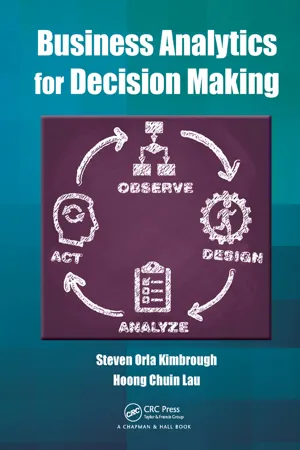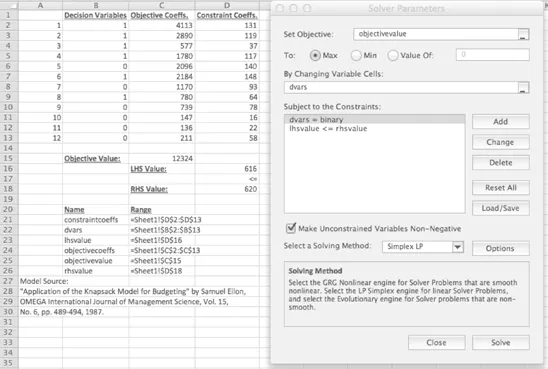
- 308 pages
- English
- ePUB (mobile friendly)
- Available on iOS & Android
Business Analytics for Decision Making
About This Book
Business Analytics for Decision Making, the first complete text suitable for use in introductory Business Analytics courses, establishes a national syllabus for an emerging first course at an MBA or upper undergraduate level. This timely text is mainly about model analytics, particularly analytics for constrained optimization. It uses implementations that allow students to explore models and data for the sake of discovery, understanding, and decision making.Business analytics is about using data and models to solve various kinds of decision problems. There are three aspects for those who want to make the most of their analytics: encoding, solution design, and post-solution analysis. This textbook addresses all three. Emphasizing the use of constrained optimization models for decision making, the book concentrates on post-solution analysis of models. The text focuses on computationally challenging problems that commonly arise in business environments. Unique among business analytics texts, it emphasizes using heuristics for solving difficult optimization problems important in business practice by making best use of methods from Computer Science and Operations Research. Furthermore, case studies and examples illustrate the real-world applications of these methods. The authors supply examples in Excel®, GAMS, MATLAB®, and OPL. The metaheuristics code is also made available at the book's website in a documented library of Python modules, along with data and material for homework exercises. From the beginning, the authors emphasize analytics and de-emphasize representation and encoding so students will have plenty to sink their teeth into regardless of their computer programming experience.
Frequently asked questions
Information
Part II
Optimization Modeling
Chapter 4
Simple Knapsack Problems
4.1 Introduction
4.2 Solving a Simple Knapsack in Excel
| Variable No. | ci | wi | ci/wi |
| 1 | 4.13 | 131 | 31.40 |
| 2 | 2890 | 119 | 24.29 |
| 3 | 577 | 37 | 15.59 |
| 4 | 1780 | 117 | 15.21 |
| 5 | 2096 | 140 | 14.97 |
| 6 | 2184 | 148 | 14.76 |
| 7 | 1170 | 93 | 12.58 |
| 8 | 780 | 64 | 12.19 |
| 9 | 739 | 78 | 9.47 |
| 10 | 147 | 16 | 9.19 |
| 11 | 136 | 22 | 6.18 |
| 12 | 211 | 58 | 3.64 |

4.3 The Bang-for-Buck Heuristic
Table of contents
- Cover
- Half Title
- Title Page
- Copyright Page
- Table of Contents
- Preface
- List of Figures
- List of Tables
- I Starters
- II Optimization Modeling
- III Metaheuristic Solution Methods
- IV Post-Solution Analysis of Optimization Models
- V Conclusion
- A Resources
- Bibliography
- Index